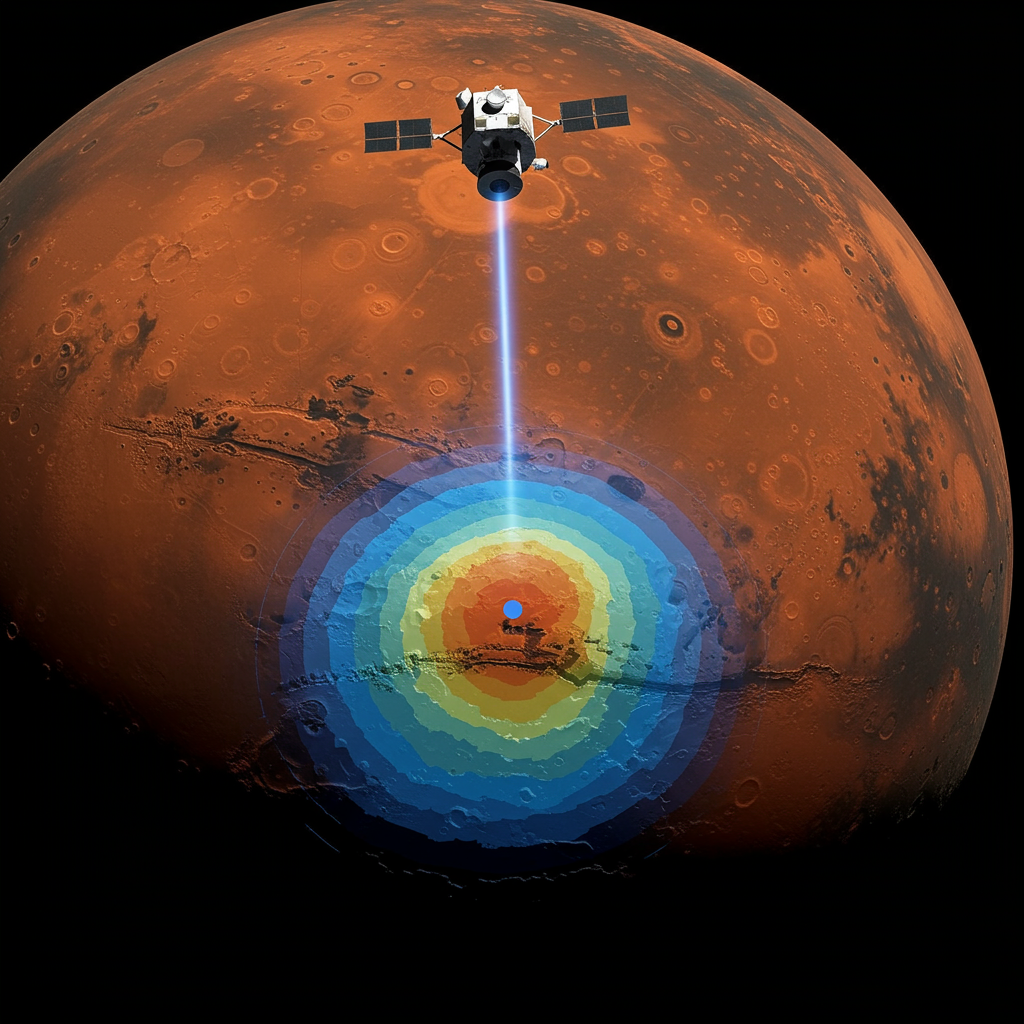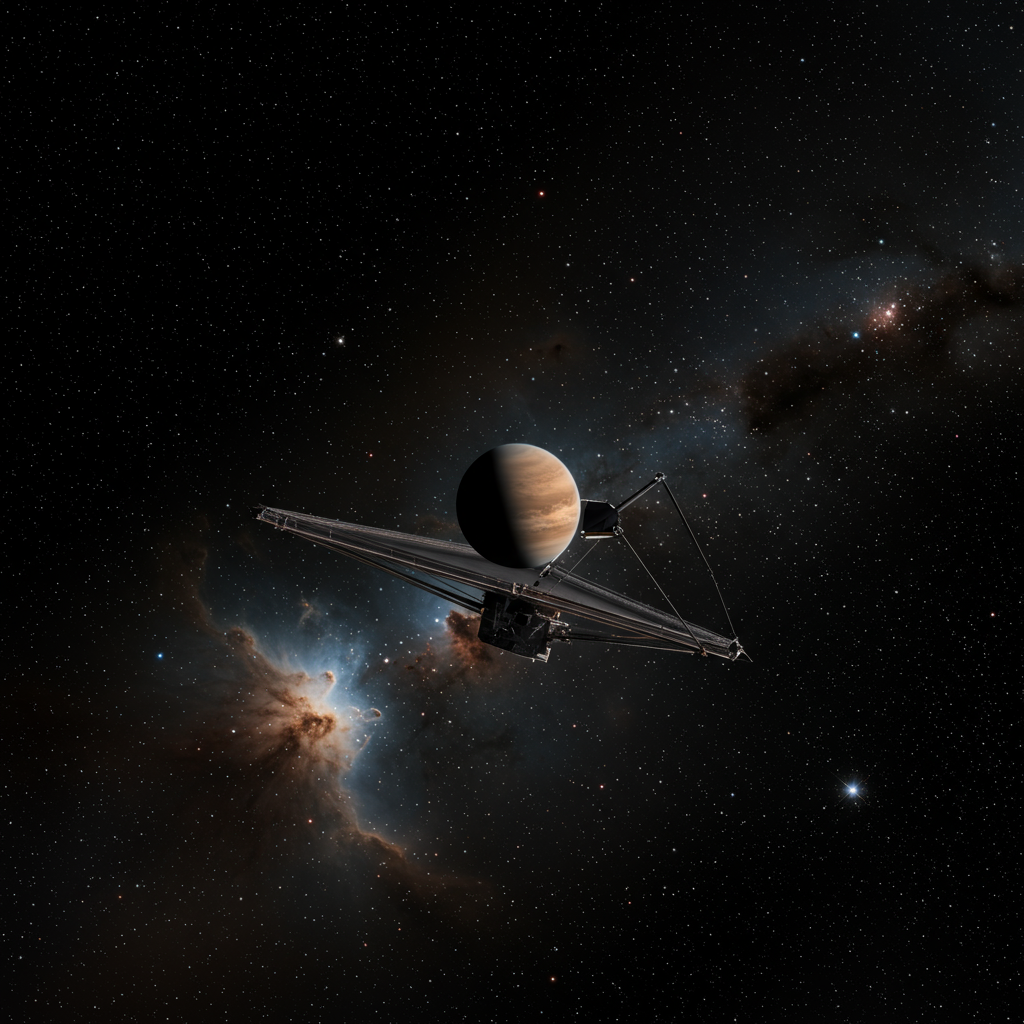A veteran spacecraft orbiting Mars has just mastered an unprecedented maneuver, allowing it to probe deeper beneath the red planet’s surface than ever before. This innovative technique significantly boosts the search for hidden water ice, a crucial element for understanding Mars’ past potential for life and its future for human exploration. Nearly two decades after its launch, the Mars Reconnaissance Orbiter (MRO), a mission with vital links to Tucson and Southern Arizona research institutions, continues to push the boundaries of planetary science.
Mars Orbiter Flips for Deeper Insight
The Mars Reconnaissance Orbiter, circling the red planet since 2006, was built with the capability to tilt up to 30 degrees for targeted observations. However, recent mission planning has seen the spacecraft perform a dramatic 120-degree flip. This sophisticated new maneuver is designed to optimally position one of its key instruments, the Shallow Radar (sharad), for enhanced subsurface scanning.
Engineers at NASA’s Jet Propulsion Laboratory (JPL) in Southern California highlighted the spacecraft’s inherent flexibility. “We’re unique in that the entire spacecraft and its software are designed to let us roll all the time,” stated Reid Thomas, MRO’s project manager at JPL. This built-in adaptability has proven essential for implementing novel observation strategies like the recent 120-degree rotation. While MRO carries five operational science instruments, usually orienting the spacecraft for one instrument means others get a less favorable view. This new flip specifically prioritizes SHARAD.
Targeting Subsurface Water on Mars
MRO’s primary mission objective has always centered on finding evidence of past or present water on Mars. Liquid water cannot persist on the Martian surface today due to the extremely thin atmosphere; the low pressure causes ice to sublimate directly into gas. Therefore, the search for Martian water focuses primarily on underground ice, particularly prevalent in the planet’s mid-latitudes.
The SHARAD instrument is specifically designed for this subsurface exploration. It operates by sending radio waves, or “pings,” down into the Martian crust. By analyzing how these waves bounce back, scientists can map layers beneath the surface and distinguish between different materials like rock, sand, and crucial ice deposits.
Scientists anticipate that the new 120-degree flip maneuver will dramatically improve SHARAD’s performance. The optimal orientation provided by the flip is expected to increase the subsurface radar instrument’s capabilities by a factor of ten or even more. This means achieving a much clearer and deeper view below the Martian surface, potentially uncovering previously undetected ice reservoirs.
Tucson’s Deep Connection to Mars Exploration
The Mars Reconnaissance Orbiter mission benefits significantly from expertise rooted in Tucson, Arizona. The High-Resolution Imaging Experiment (HiRISE) camera, one of MRO’s powerful instruments, is a prime example. This camera, capable of capturing vast areas of Martian terrain while resolving features as small as a kitchen table, is a collaboration between NASA and the University of Arizona (UA).
Beyond imaging, Tucson-based scientists play a crucial role in the SHARAD operations as well. The Planetary Science Institute (PSI) in Tucson is a key participant. Nathaniel Putzig, associate director and senior scientist at PSI, leads the U.S. operations contingent for SHARAD. While SHARAD itself is an Italian contribution to the MRO mission, the U.S. team provides vital support and analysis. The University of Arizona also contributes two other crew members to the SHARAD team, further cementing Tucson’s impact on this pioneering mission.
MRO’s Enduring Legacy and Future Outlook
Having operated successfully for nearly two decades, the Mars Reconnaissance Orbiter is a testament to robust spacecraft engineering and persistent scientific inquiry. Initially designed with specific goals related to finding water evidence, MRO has accomplished many of its original objectives. Its remarkable longevity allows the mission team to propose and pursue new scientific endeavors, extending its scientific output well beyond its initial scope.
Nathaniel Putzig highlighted this aspect, noting, “MRO has been doing great science for nearly 20 years… Now, we’ve had the opportunity to propose new and different things we hadn’t done throughout the mission.” He added that the 120-degree flip maneuver is just “one of many things this veteran mission is doing that is having a demonstrable impact on science and our understanding of Mars.”
The orbiter uses reaction wheels for its maneuvers, powered by the spacecraft’s battery. Importantly for its future, MRO retains sufficient fuel reserves to comfortably continue operations potentially into the mid-2030s, promising many more years of valuable data collection.
Navigating Potential Budget Headwinds
Despite the scientific successes and technical health of the spacecraft, the MRO mission, like much of the U.S. space program, faces potential fiscal challenges. The Southern Arizona space industry, heavily involved in missions like MRO, has been bracing for possible budget cuts outlined in NASA’s budget proposal for fiscal year 2026.
The proposed budget reportedly prioritizes manned missions, aiming to accelerate goals like returning to the Moon and eventually landing humans on Mars. This focus comes at the expense of significant reductions in science programs. The proposal explains that to align with administration objectives, the budget would “reduce lower priority research and terminate unaffordable missions.” Worryingly, every single mission program except human exploration could see cuts as high as nearly 50%.
While the proposed cuts are severe for many missions, the impact on MRO appears relatively milder by comparison. Nathaniel Putzig noted that the president’s FY26 budget request shows a reduction of approximately $1 million for MRO. He cautioned, however, that this amount, though “relatively mild compared to the broader devastation proposed for other missions and research efforts,” could still pose difficulties. If enacted, such cuts would likely impact the science teams more significantly than the operations staff, which has already seen substantial reductions over the years. Putzig warned that excessive cuts to operations could potentially jeopardize the spacecraft itself.
These budget discussions underscore the delicate balance in space exploration funding, where prioritizing ambitious human endeavors can strain vital scientific research missions that provide foundational knowledge about destinations like Mars.
Frequently Asked Questions
What is the new maneuver the Mars Reconnaissance Orbiter is performing?
The Mars Reconnaissance Orbiter (MRO) is now performing a new maneuver involving a 120-degree flip of the spacecraft. This is a significant departure from its previous capability to tilt up to 30 degrees. The purpose of this larger rotation is to precisely center and optimize the positioning of the SHARAD subsurface radar instrument, allowing it to achieve clearer and deeper penetration into the Martian crust.
Which organizations are involved in the MRO mission, especially concerning the SHARAD instrument and the Tucson link?
NASA’s Jet Propulsion Laboratory (JPL) manages the MRO mission. The SHARAD instrument itself is an Italian contribution, but the U.S. operations are led by the Planetary Science Institute (PSI) in Tucson. Nathaniel Putzig is a key scientist at PSI involved in SHARAD operations. The University of Arizona (UA), also based in Tucson, is involved with the HiRISE camera instrument and has team members contributing to SHARAD.
How do potential budget cuts affect Mars missions like MRO and space research in Southern Arizona?
NASA’s proposed budget for fiscal year 2026 suggests prioritizing manned missions, leading to potential significant cuts (up to 50%) for science programs. While MRO’s proposed cut is relatively smaller ($1 million) compared to others, any reduction could impact the mission’s science teams and research efforts. These potential cuts affect the broader Southern Arizona space industry, including programs at the University of Arizona, prompting concern among researchers and engineers in the region.
A Veteran Explores Anew
The Mars Reconnaissance Orbiter’s adoption of this new, precise maneuver exemplifies how long-duration missions can evolve and continue contributing valuable scientific data. By enabling the SHARAD instrument to see deeper underground, scientists move closer to mapping the hidden water ice that holds clues about Mars’ past and potential future. Despite the looming uncertainty of budget proposals, the MRO mission, supported by critical contributions from institutions like the University of Arizona and the Planetary Science Institute in Tucson, remains a vital asset in humanity’s ongoing exploration of the red planet.
References
- <a href="https://www.tucsonsentinel.com/local/report/062725marsorbiter/”>www.tucsonsentinel.com
- <a href="https://www.tucsonsentinel.com/arts/report/062825monsoonfantasy/”>www.tucsonsentinel.com




